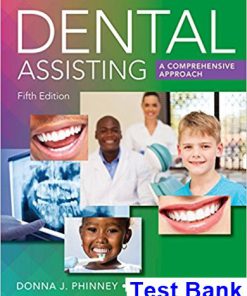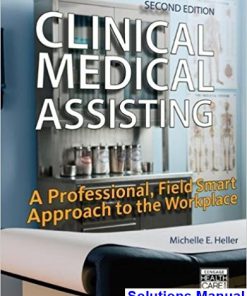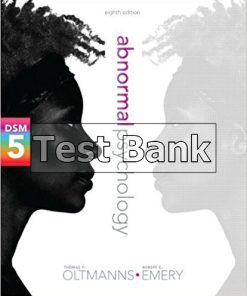Comprehensive Medical Assisting Administrative and Clinical Competencies 6th Edition Lindh Test Bank
$50.00 Original price was: $50.00.$26.50Current price is: $26.50.
Comprehensive Medical Assisting Administrative and Clinical Competencies 6th Edition Lindh Test Bank.
This is completed downloadable of Comprehensive Medical Assisting Administrative and Clinical Competencies 6th Edition Lindh Test Bank

Product Details:
- ISBN-10 : 9781305964792
- ISBN-13 : 978-1305964792
- Author: Wilburta Q. Lindh (Author), Marilyn Pooler (Author), Carol D. Tamparo (Author), Barbara M. Dahl (Author), Julie Morris (Author)
Medical assistants play a critical role in our changing world of health care, and COMPREHENSIVE MEDICAL ASSISTING, Sixth Edition, prepares them to lead in this growing field. Known for accuracy, completeness of coverage, and exacting technical detail, this proven book addresses the administrative and clinical tasks required of medical assistants while preparing them for certification exams. Divided into three sections, chapters start with general topics, including therapeutic communications, coping skills, and professionalism. Administrative chapters look behind the scenes, exploring electronic medical records, ICD-10 coding, and practice management. COMPREHENSIVE MEDICAL ASSISTING also maps clinical topics to ABHES, CAAHEP, and MAERB competencies, as well as CLIA-waived procedures, and delivers an exhaustive set of skills: taking patient medical histories, recording vital signs, explaining procedures, assisting during exams and surgery, infection control, and more.
Table of Content:
- Section I: General Procedures
- Unit I: Introduction to Medical Assisting and Health Professions
- Chapter 1: The Medical Assisting Profession
- Historical Perspective of the Profession
- Career Opportunities
- Education of the Medical Assistant
- Accreditation of Medical Assisting Programs
- Attributes of a Medical Assistant Professional
- American Association of Medical Assistants (AAMA)
- American Medical Technologists
- Other Certification
- Regulation of Health Care Providers
- Chapter 2: Health Care Settings and the Health Care Team
- Ambulatory Health Care Settings
- The Health Care Team
- Allied Health Professionals and Their Roles
- The Value of the Medical Assistant to the Health Care Team
- Unit II: The Therapeutic Approach
- Chapter 3: Coping Skills for the Medical Assistant
- What Is Stress?
- Factors Causing Stress in the Work Environment
- Ways to Reduce Stress
- Effect of Prolonged Stress – Burnout
- Chapter 4: Therapeutic Communication Skills
- Therapeutic Communication Defined
- The Communication Cycle
- Verbal and Nonverbal Communication
- Influence of Technology on Communication
- Factors Affecting Therapeutic Communication
- Roadblocks to Therapeutic Communication
- Barriers Caused by Cultural and Religious Diversity
- Establishing Multicultural Communication
- Therapeutic Communication in Action
- Patient Coaching and Navigation
- Chapter 5: The Therapeutic Approach to the Patient with a Life-Threatening Illness
- Life-Threatening Illness
- Choices in Life-Threatening Illness
- The Range of Psychological Suffering
- Patients with Cancer
- Patients with HIV/AIDS
- Patients with End-Stage Renal Disease
- The Therapeutic Response to Patients with Life-Threatening Illnesses
- Communication in End-of-Life Care
- The Stages of Grief
- The Challenge for the Medical Assistant
- Unit III: Responsible Medical Practice
- Chapter 6: Legal Considerations
- Sources of Law
- Administrative Law
- Contract Law
- Tort Law
- Informed Consent
- Risk Management
- Civil Litigation Process
- Statute of Limitations
- Public Duties
- Fraud
- Advance Directives
- Chapter 7: Ethical Considerations
- Ethics
- Keys to the AAMA Code of Ethics
- Ethical Guidelines for Health Care Providers
- Bioethics
- Allocation of Scarce or Limited Medical Resources
- Chapter 8: Emergency Procedures and First Aid
- Recognizing an Emergency
- Preparing for an Emergency
- Common Emergencies
- Breathing Emergencies and Cardiac Arrest
- Safety and Emergency Practices
- Section II: Administrative Procedures
- Unit IV: Integrated Administrative Procedures
- Chapter 9: Creating the Facility Environment
- Creating a Welcoming Environment
- The Reception Area
- Clinic Design and Environment
- Legal Compliance in the Facility
- Safety
- Opening the Facility
- Closing the Facility
- The Future Environment for Ambulatory Care
- Chapter 10: Computers in the Medical Clinic
- Categories of Computers
- Basic Computer Elements
- Cloud Computing
- Computer Maintenance
- Use of Computers in the Medical Clinic
- Design Considerations for a Computerized Medical Clinic
- Ergonomics
- Patient Confidentiality Related to a Computerized Medical Clinic
- Chapter 11: Telecommunications
- Basic Telephone Techniques
- Routing Calls in the Medical Clinic
- Telephone Documentation
- Using Telephone Directories
- Placing Outgoing Calls
- Placing Long-Distance Calls
- Legal and Ethical Considerations
- HIPAA Guidelines for Telephone Communications
- Americans with Disabilities Act (ADA)
- Telephone Technology
- Professionalism in Telecommunications
- Chapter 12: Patient Scheduling
- Tailoring the Scheduling System
- Scheduling Styles
- Analyzing Patient Flow
- Legal Issues
- Interpersonal Skills
- Guidelines for Scheduling Appointments
- Scheduling Software and Materials
- Inpatient and Outpatient Admissions Procedures
- Chapter 13: Medical Records Management
- The Purpose of Medical Records
- Ownership of Medical Records
- Authorization to Release Information
- Manual or Electronic Medical Records
- The Importance of Accurate Medical Records
- Types of Medical Records
- Equipment and Supplies
- Basic Rules for Filing
- Steps for Filing Medical Documentation in Patient Files
- Filing Techniques and Common Filing Systems
- Filing Procedures
- Correspondence
- Electronic Medical Records
- Chapter 14: Written Communications
- Composing Correspondence
- Components of a Business Letter
- Letter Styles
- Supplies for Written Communication
- Other Types of Correspondence
- Processing Incoming and Outgoing Mail
- Legal and Ethical Issues
- Chapter 15: Medical Documents
- The Changing Role of Medical Transcription
- Confidentiality and Legal Issues
- Types of Medical Documents
- Turnaround Time and Productivity
- Medical Transcription as a Career
- Unit V: Managing Facility Finances
- Chapter 16: Medical Insurance
- Understanding the Role of Health Insurance
- Medical Insurance Terminology
- Types of Medical Insurance Coverage
- Screening for Insurance
- Referrals and Authorizations
- Determining Fee Schedules
- Legal and Ethical Issues
- Professional Careers in Insurance
- Chapter 17: Medical Coding
- Insurance Coding Systems Overview
- Code Sets
- Medical Coding
- Coding Accuracy
- Coding the Claim Form
- Third-Party Privacy, Security, and Compliance Guidelines
- Completing the CMS-1500 (02-12)
- Benefits of Submitting Claims Electronically
- Managing the Claims Process
- The Insurance Carrier’s Role
- Legal and Ethical Issues
- Chapter 18: Daily Financial Practices
- Patient Fees
- Credit Arrangements
- The Bookkeeping Function
- Recording Patient Transactions
- Banking Procedures
- Purchasing Supplies and Equipment
- Petty Cash
- Chapter 19: Billing and Collections
- Billing Procedures
- Credit and Collection Policies
- Payment at Time of Service
- Truth-in-Lending Act
- Components of a Complete Statement
- Monthly and Cycle Billing
- Past-Due Accounts
- Collection Process
- Aging Accounts
- Collection Techniques
- Use of an Outside Collection Agency
- Use of Small Claims Court
- Special Collection Situations
- Statute of Limitations
- Maintain a Professional Attitude
- Chapter 20: Accounting Practices
- Bookkeeping and Accounting Systems
- Day-End Summary
- Accounts Receivable Trial Balance
- Accounts Payable
- The Accounting Function
- Cost Analysis
- Financial Records
- Useful Financial Data
- Legal and Ethical Guidelines
- Section III: Clinical Procedures
- Unit VI: Integrated Clinical Procedures
- Chapter 21: Infection Control and Medical Asepsis
- Impact of Infectious Diseases
- The Process of Infection
- Infection Cycle
- The Body’s Defense Mechanisms for Fighting Infection and Disease
- Stages of Infectious Diseases
- Disease Transmission
- Human Immunodeficiency Virus and Hepatitis B and C
- Reporting Infectious Disease
- Standard Precautions
- OSHA Regulations
- Principles of Infection Control
- Medical Asepsis
- Bioterrorism
- Chapter 22: The Patient History and Documentation
- The Purpose of the Medical History
- Preparing for the Patient
- A Cross-Cultural Model
- Patient Information Forms
- Electronic Health History
- The Patient Intake Interview
- Communication across the Life Span
- The Medical Health History
- SOAP/SOAPI/SOAPIER/SOAPER and CHEDDAR
- The Patient Record and Its Importance
- Methods of Charting/Documentation
- Electronic Medical Record (EMR)
- Rules of Charting
- Chapter 23: Vital Signs and Measurements
- The Importance of Accuracy
- Temperature
- Pulse
- Pulse Sites
- Respiration
- Blood Pressure
- Height and Weight
- Measuring Chest Circumference
- Chapter 24: The Physical Examination
- Methods of Examination
- Positioning and Draping
- Equipment and Supplies for the Physical Examination
- Basic Components of a Physical Examination
- The Physical Examination Sequence
- After the Examination
- Unit VII: Assisting with Specialty Examinations and Procedures
- Chapter 25: Obstetrics and Gynecology
- Obstetrics
- Gynecology
- Chapter 26: Pediatrics
- What Is Pediatrics?
- Immunizations
- Theories of Growth and Development
- Growth Patterns
- Pediatric Vital Signs
- Collecting a Urine Specimen from an Infant
- Screening Infants for Hearing Impairment
- Screening Infant and Child Visual Acuity
- Common Childhood Illnesses
- Male Circumcision
- Chapter 27: Male Reproductive System
- Anatomy of Male Reproductive System
- Disorders of the Male Reproductive System
- Treatment and Diagnosis of Diseases and Disorders of the Male Reproductive System
- Assisting with the Male Reproductive Examination
- Chapter 28: Gerontology
- Societal Bias
- Facts about Aging
- Physiologic Changes
- Safety
- Psychological Changes
- The Medical Assistant and the Geriatric Patient
- Healthy and Successful Aging
- Chapter 29: Examinations and Procedures of Body Systems
- Integumentary System
- Neurologic System
- Sensory System
- Respiratory System
- Signs and Symptoms of Respiratory Conditions and Disorders
- Inhalers
- Circulatory System
- Blood and Lymph System
- Musculoskeletal System
- Digestive System
- Urinary System
- Unit VIII: Advanced Techniques and Procedures
- Chapter 30: Assisting with Minor Surgery
- Surgical Asepsis and Sterilization
- Sterile Principles
- Methods of Sterilization
- Common Surgical Procedures Performed in Providers’ Offices and Clinics
- Additional Surgical Methods
- Suture Materials and Supplies
- Instruments
- Supplies and Equipment
- Patient Care and Preparation
- Basic Surgery Setup
- Surgery Process
- Preparation for Surgery
- Chapter 31: Diagnostic Imaging
- Radiation Safety
- Radiography Equipment
- Contrast Media
- Patient Preparation
- Positioning the Patient
- Fluoroscopy
- Bone Densitometry
- Diagnostic Imaging
- Radiation Therapy
- Nuclear Medicine
- Chapter 32: Rehabilitation and Therapeutic Modalities
- The Role of the Medical Assistant in Rehabilitation
- Principles of Body Mechanics
- Using the Body Safely and Effectively
- Transferring Patients
- Assisting Patients to Ambulate
- Assistive Devices
- Therapeutic Exercises
- Therapeutic Modalities
- Chapter 33: Nutrition in Health and Disease
- Nutrition and Digestion
- Types of Nutrients
- Reading Food Labels
- Nutrition at Various Stages of Life
- Therapeutic Diets
- Special Dietary Requirements
- Diet and Culture
- Chapter 34: Basic Pharmacology
- Uses of Medications
- Research and Development
- Drug Names
- History and Sources of Drugs
- Drug Regulations and Legal Classifications of Drugs
- Drug References and Standards
- Classification of Drugs
- Principal Actions of Drugs
- Drug Routes
- Forms of Drugs
- Storage and Handling of Medications
- Emergency Medications and Supplies
- Drug Abuse
- Chapter 35: Calculation of Medication Dosage and Medication Administration
- Legal and Ethical Implications of Medication Administration
- Drug Dosage
- The Medication Label
- Calculation of Drug Dosages
- Medications Measured in Units
- Calculating Adult Dosages
- Calculating Children’s Dosages
- Administration of Medications
- Administration of Oral Medications
- Administration of Parenteral Medications
- Principles of Intravenous Therapy
- Site Selection and Injection Angle
- Basic Guidelines for Administration of Injections
- Z-Track Method of Intramuscular Injection
- Administration of Allergenic Extracts
- Administration of Inhaled Medications
- Chapter 36: Cardiac Procedures
- Anatomy of the Heart
- Electrical Conduction System of the Heart
- The Cardiac Cycle and the ECG Cycle
- Types of Electrocardiographs
- ECG Equipment
- The Electrocardiograph and Sensor Placement
- Standardization and Adjustment of the Electrocardiograph
- Standard Resting Electrocardiography
- Mounting the ECG Tracing
- Interference or Artifacts
- Myocardial Infarctions (Heart Attacks)
- Cardiac Arrhythmias
- Defibrillation
- Other Cardiac Diagnostic Tests
- Cardiac Procedures
- Unit IX: Laboratory Procedures
- Chapter 37: Regulatory Guidelines for Safety and Quality in the Medical Laboratory
- Clinical Laboratory Improvement Amendments (CLIA)
- OSHA Regulations
- OSHA Regulations and Students
- Chapter 38: Introduction to the Medical Laboratory
- The Laboratory
- Billing for Laboratory Services
- Quality Controls/Assurances in the Laboratory
- Laboratory Requisitions and Reports
- The Specimen
- Microscopes
- Chapter 39: Phlebotomy: Venipuncture and Capillary Puncture
- Why Collect Blood?
- The Medical Assistant’s Role in Phlebotomy
- Anatomy and Physiology of the Circulatory System
- Blood Collection
- Venipuncture Equipment
- Venipuncture Principles
- Specimen Collection
- Capillary Puncture
- Chapter 40: Hematology
- The Formation of Blood Cells
- Hematologic Tests
- Hemoglobin and Hematocrit Tests
- White and Red Blood Cell Counts
- Platelets
- Erythrocyte Indices
- Erythrocyte Sedimentation Rates (ESR or SED Rate)
- C-Reactive Proteins
- Coagulation Studies (INR and Protime)
- Automated Hematology
- Chapter 41: Urinalysis
- Urine Formation
- Urine Composition
- Safety
- Quality Control
- Clinical Laboratory Improvement Amendments (CLIA)
- Urine Containers
- Urine Collection
- Culture and Sensitivity of Urine
- Examination of Urine
- Drug Screening
- Chapter 42: Basic Microbiology
- The Medical Assistant’s Role in the Microbiology Laboratory
- Microbiology
- Equipment
- Safety when Handling Microbiology Specimens
- Quality Control
- Collection Procedures
- Foodborne Illnesses
- Virology (Viruses) in the Medical Laboratory
- Bacteriology (Bacteria) in the Medical Laboratory
- Parasitology (Parasites) in the Medical Laboratory
- Mycology (Fungi) in the Medical Laboratory
- Chapter 43: Specialty Laboratory Tests
- Urine Pregnancy Tests
- Infectious Mononucleosis
- Prothrombin Time
- Blood Typing
- Semen Analysis
- Phenylketonuria Test
- Tuberculosis
- Thyroid
- Blood Glucose
- Cholesterol, Lipids, and Systemic Inflammation
- Blood Chemistry Tests
- Section IV: Professional Procedures
- Unit X: Clinic and Human Resources Management
- Chapter 44: The Medical Assistant as Clinic Manager
- The Medical Assistant as Clinic Manager
- Qualities of a Manager
- Management Styles
- Risk Management
- Importance of Teamwork
- Supervising Personnel
- Procedure Manual
- HIPAA Implications
- Travel Arrangements
- Time Management
- Marketing Functions
- Social Media and the Medical Clinic
- Records and Financial Management
- Facility and Equipment Management
- Liability Coverage and Bonding
- Legal Issues
- Chapter 45: The Medical Assistant as Human Resources Manager
- Tasks Performed by the Human Resources Manager
- The Clinic Policy Manual
- Recruiting and Hiring Clinic Personnel
- Orienting New Personnel
- Evaluating Employees
- Dismissing Employees
- Maintaining Personnel Records
- Complying with Personnel Laws
- Special Policy Considerations
- Providing/Planning Employee Instruction and Education
- Unit XI: Entry into the Profession
- Chapter 46: Preparing for Medical Assisting Credentials
- Purpose of Certification
- Certification Agencies
- Preparing for Certification Examinations
- American Association of Medical Assistants (AAMA)
- American Medical Technologists (AMT)
- National Healthcareer Association (NHA)
- Professional Organizations
- Chapter 47: Employment Strategies
- Developing a Strategy
- The Job Search
- Resume Preparation or Online Profile
- Application/Cover Letters
- Completing the Application Form
- The Interview Process
- Interview Follow-Up
- After You Are Employed
- Appendix A: Common Health Care Abbreviations and Symbols
- Glossary of Terms
- References/Bibliography
- Index
People Also Search:
medical assisting administrative and clinical competencies lindh
medical assisting administrative and clinical competencies 6th edition lindh
medical assisting administrative and clinical competencies
medical assisting administrative and clinical competencies 6th edition
medical assisting administrative and clinical competencies 6th edition download scribd
medical assisting administrative and clinical competencies 6th edition testbank download pdf
Instant download after Payment is complete
You may also like…
Test Bank
Todays Medical Assistant Clinical and Administrative Procedures 2nd Edition Bonewit Test Bank




















